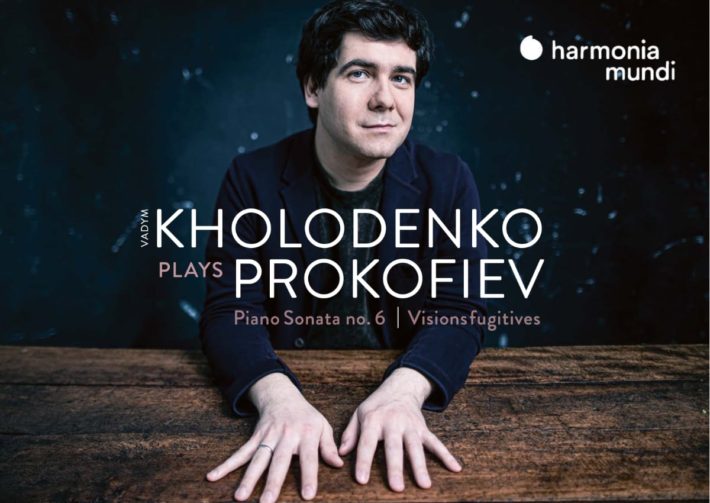Prokofiev’s Sixth Sonata (Op. 82) was written in 1939, is the first of three “War Sonatas.” Although Prokofiev did not associate his music much with politics in the way Shostakovich did, these works provide musical commentary on World War II and its effects on humanity. On an even larger scale, Op. 82 is a timeless and striking montage of the complex emotions associated with the theme of conflict, the jarring dissonances of the first movement depict the madness and calamity of war.
Vadym Kholodenko, winner of the 14th Van Cliburn competition, has gravitas, but his roundness of tone is at odds with what the movement can express; the opening, for instance, is missing the electric energy of Pogorelich’s recording on DG. What drives the middle sections of this movement is a persisting unease, even in its most lyrical moments. While the pianist shapes phrases in a lovely fashion, the dynamism is sacrificed, partly due to overly muted accents (Prokofiev places these stresses on “unnatural” beats to create imbalance and unpredictability).
The second movement, with its off-kilter humor, portrays the marching of soldiers through its omnipresent metronomic figures. The performance is precisely articulated and gives the movement a lightheartedness on the surface. but this is where interpretation gets interesting: if we were to listen to this movement alone, what we’d take away is joviality. However, when placed against the previous movement, the sarcasm becomes apparent; the cheerfulness suddenly seems like an incongruous caricature.
The third movement, while not the most technically challenging per se, is the most musically difficult. If this Sonata is an embodiment of conflict, this movement is its emotional pinnacle – a slow waltz that reminiscences upon a humanity that has been stolen away by the war. The longing for it transforms in the climactic moments into frustration and passion. Given Prokofiev’s normally sardonic and cynical nature, this movement is a rare glimpse into a sensitive emotional persona. Kholodenko possesses a deep and satisfying vitality here that was wanting in the first movement. The final movement hints at motivic, thematic, and emotional elements from the prior three, but with a decidedly menacing feel. Though the performance is solid, it again feels held back, particularly in the final moments, where there is a complete dissolution into chaos. It lacks the urgency and madness that, say, Boris Berman’s interpretation (Chandos) evokes so effectively.
Related Classical Music Reviews
- Review – Tchaikovsky Piano Concerto No. 1, Prokofiev Piano Concerto No. 2 – Haochen Zhang, Piano
- Review: Shostakovich – Symphony No. 11 – BBC Philharmonic – Storgårds
- Review: Poulenc – Piano Concertos, Chamber Works – Mark Bebbington
The Op. 22 Visions Fugitives (1915-1917) are a set of 20 miniatures inspired by the writing of Russian Symbolist poet Konstantin Balmont. It’s intriguing to note that they were written in the same era as some of Prokofiev’s earlier sonatas (1-4); while the Sonatas have recognizable elements of his compositional style, the Visions are a different story: they show him seemingly experimenting with Impressionism (the Debussian harmonies in No. 1) or atonality (No. 2). Kholodenko’s sound quality complements the work very well here, where many of the vignettes are lyrical, whimsical, or contemplative. No. 7 (track 17), is a highlight: the gentle moments are calm and floating, creating a sudden contrast to the flare of emotion (2’02”) that takes the listener by surprise and fades as quickly as it came. No. 8 muses along with hints of wistfulness: there are beautiful gradations of piano from Kholodenko, who also uses the ostinato figures to shape the melody itself. On the opposite end of the spectrum in length and style, No. 19 is capricious and exciting. Overall, the performance captures the true sense of the title: we are able to experience and enjoy the personality of each piece just before it is whisked away.
Things in Themselves and the Four Pieces for Piano (Op. 45 and 32, respectively) are a nice addition that gives the listener a more comprehensive perspective into Prokofiev’s compositional trajectory. The Four Pieces, a series of different stylized dances, are particularly enjoyable; the standouts are the Minuet with its charm and humor and the stylistically eclectic Gavotte, whose Impressionist harmonies give way to vestiges of neo-Romanticism.
The recording was made in Fazioli’s hall in Sacile. The sound engineering is of middling quality – though the resonant tone of the Fazioli comes through vividly, there are at times noticeable sounds in the background that detract from an otherwise solid performance, even with reservations about the Sonata.

Prokofiev – Piano Sonata No. 6, Visions Fugitives, Choses en soi, Quatre pièces de danse
Vadym Kholodenko – Piano
Harmonia Mundi, CD HMM 902659
Recommended Comparisons
Read more classical music reviews or visit The Classic Review Amazon store
Follow Us and Comment:
[wd_hustle id=”HustlePostEmbed” type=”embedded”]











